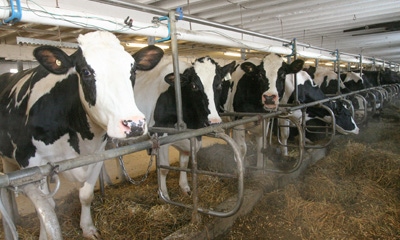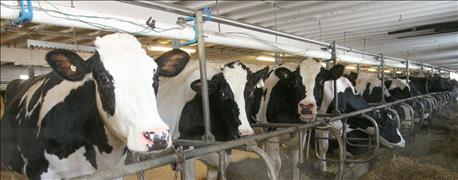September 16, 2016

Synchronization protocols have been widely incorporated into reproductive management programs by dairy farmers. Because the value of a pregnancy is measured in hundreds of dollars, a farmer can make economical modifications to an original Ovsynch protocol to include the use of a presynchronization strategy and dramatically increase pregnancy rate in a dairy herd.
The initial impact of these protocols on 21-day pregnancy rates in U.S. dairy herds has been to increase the artificial insemination service rate; however, a deeper understanding of the physiology underlying the Ovsynch protocol has allowed for an increase in fertility to timed AI.

FERTILITY STUDY: Data was collected from 7,792 cows from 14 experiments to measure progesterone during an Ovsynch protocol.
Progesterone is the most biologically active progestogen in cattle, and is primarily produced and secreted by the corpus luteum (CL) during the estrous cycle and the placenta during pregnancy. Much research has focused on the role of progesterone on fertility during an Ovsynch protocol as measured by pregnancies per artificial insemination 32 days after timed AI.
There is a relationship between progesterone concentrations at each treatment of an Ovsynch protocol and pregnancies per artificial insemination in lactating Holstein cows. We analyzed data from 7,792 cows from 14 experiments to measure progesterone during an Ovsynch protocol. The most common resynchronization strategies have used two prostaglandin treatments administered 14 days apart, with the second treatment administered 10 to 14 days before initiation of an Ovsynch protocol (i.e., presynch-Ovsynch) or a combination of GnRH and prostaglandin six to seven days before initiation of an Ovsynch protocol (i.e., double-Ovsynch).
We found an increase in pregnancies per artificial insemination when progesterone concentrations were increased at the time of the prostaglandin treatment of the Ovsynch protocol. Both presynch-Ovsynch and double-Ovsynch increase pregnancies per artificial insemination to first timed AI; however, presynch-Ovsynch does not increase pregnancies per artificial insemination in noncycling cows because they lack a CL. Double-Ovsynch induces cyclicity in most of these cows, thereby increasing pregnancies per artificial insemination in noncycling cows.
A critical factor associated with pregnancies per artificial insemination to timed AI is progesterone at last GnRH treatment. Based on the study data, a major problem with the original Ovsynch protocol is that some cows fail to fully regress their CL, resulting in progesterone levels at the last GnRH treatment that limit fertility. The cause of this decreased fertility to timed AI is not clear. One possibility is a negative association between progesterone during the estrous cycle and uterine muscle contraction resulting in decreased fertilization rate.
A recent modification of the original Ovsynch protocol is to add a second prostaglandin treatment 24 hours after the first within the protocol. The addition of this treatment helps to fully regress CL that otherwise do not regress to a single prostaglandin treatment, thereby decreasing progesterone at the last GnRH treatment. Several experiments have tested the effect of this modification at both first and resynch timed AI. Adding the second prostaglandin treatment to a double-Ovsynch protocol for first timed AI produced 4.6% more pregnancies in first-lactation cows and 23% more pregnancies for second-lactation and older cows. Adding the second prostaglandin treatment within a resynch protocol produced 22% more pregnancies.
The use of presynchronization strategies for first timed AI and addition of a second prostaglandin treatment for first and resynch timed AI are economical modifications to the original Ovsynch protocol that can dramatically increase pregnancy rate in a dairy herd. Taken together, these modifications can turn your synchronization program into a fertility program.
Fricke is an assistant professor at University of Wisconsin-Madison and an Extension specialist in dairy cattle reproduction.
You May Also Like




